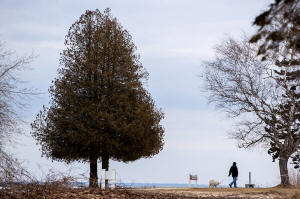Central US seeing wild weather, with heat wave then deep freeze
 Send a link to a friend
Send a link to a friend
 [February 27, 2024]
By Brad Brooks [February 27, 2024]
By Brad Brooks
(Reuters) - Some U.S. residents will be going from wearing Bermuda
shorts to snow pants in less than 24 hours, forecasters said on Monday,
as a heat wave in the central Plains and South gives way to weather more
typical for this time of year.
Temperatures on Monday in states like Nebraska and Iowa were in the
mid-70s Fahrenheit (low 20s Celsius), some 40 degrees F (22 degrees C)
above averages for this time of year, while cities in the South, such as
Dallas, Texas, sizzled in the mid-90s F (mid-30s C).
This week's heat wave follows other unusual weather across the U.S. this
winter - from "atmospheric river" rains in California that dumped a
year's worth of rain in a matter of hours, to historic low levels of ice
cover atop the Great Lakes.
Forecasters said it was hard to pinpoint any single weather pattern to
human-induced climate change, but extreme weather is becoming more
frequent because of it. Scientists say the prevailing El Nino weather
pattern is also contributing to the unusual weather.
Joe Wegman, a meteorologist with the National Weather Service, said an
unusual culprit is contributing to this week's heat wave.
"Most of the eastern two-thirds of the country has had a relatively
snow-less winter, so the ground is bare and dry," Wegman said. "So we're
getting much warmer temperatures just due to solar radiation."
That solar radiation is combining with warmer winds surging up from the
Gulf of Mexico to push several locations to potential record high
temperatures. Wegman said the heat wave will move quickly eastward
across the U.S. and blow out to the Atlantic by Thursday.

[to top of second column]
|

A person walks with a dog near the Mackinac Bridge, which spans the
Straits of Mackinac between Lakes Michigan and Huron in Mackinaw
City, Michigan, U.S. February 25, 2024. REUTERS/Carlos Osorio/File
Photo

Some spots seeing unusually warm weather on Monday will get slammed
by a cold front on Tuesday, Wegman said. He pointed to Grand Forks,
North Dakota, where Monday's high was to be 55 F, followed by
Tuesday highs of 9 F with a wind chill of -20 F (-29 C).
Meanwhile, scientists with the U.S. National Oceanic and Atmospheric
Administration's Great Lakes environmental research laboratory said
ice cover on the lakes was at historic lows. Coverage ranged from 0%
on Lake Erie to 10% on Lake Huron, according to the lab's data.
Peak ice season for the Great Lakes happens in early March - so some
recovery is still possible.
Ice is a vital part of the Great Lakes' ecosystem. It provides a
buffer against shoreline erosion due to the large waves common in
winter, and protection for eggs laid by several fish species.
Ice cover on the Great Lakes has been decreasing by 5% per decade
because of warmer weather, the laboratory said in a report last
week, for a 25% reduction from 1973 to 2023.
(Reporting by Brad Brooks in Longmont, Colorado, and Jonathan Allen
in New York City; editing by Donna Bryson and David Gregorio)
[© 2024 Thomson Reuters. All rights reserved.]This material
may not be published, broadcast, rewritten or redistributed.
Thompson Reuters is solely responsible for this content. |